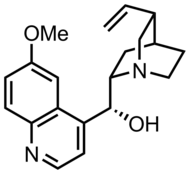Quinuclidine
| |||
| Names | |||
|---|---|---|---|
| Preferred IUPAC name
1-Azabicyclo[2.2.2]octane[2] | |||
| Other names
Quinuclidine[2]
| |||
| Identifiers | |||
3D model (
JSmol ) |
|||
| 103111 | |||
| ChEBI | |||
| ChEMBL | |||
| ChemSpider | |||
ECHA InfoCard
|
100.002.625 | ||
| EC Number |
| ||
| 26726 | |||
PubChem CID
|
|||
| UNII | |||
CompTox Dashboard (EPA)
|
|||
| |||
| |||
| Properties | |||
| C7H13N | |||
| Molar mass | 111.188 g·mol−1 | ||
| Density | 0.97 g/cm3 | ||
| Melting point | 157 to 160 °C (315 to 320 °F; 430 to 433 K) | ||
| Boiling point | 149.5 °C (301.1 °F; 422.6 K) at 760 mmHg | ||
| Acidity (pKa) | 11.0 (conjugate acid) | ||
| Hazards | |||
| GHS labelling:[3] | |||
  
| |||
| Danger | |||
| H301, H310, H315, H318 | |||
| P262, P264, P264+P265, P270, P280, P301+P316, P302+P352, P305+P354+P338, P316, P317, P321, P330, P332+P317, P361+P364, P362+P364, P405, P501 | |||
| Flash point | 36.5 °C (97.7 °F; 309.6 K) | ||
Except where otherwise noted, data are given for materials in their standard state (at 25 °C [77 °F], 100 kPa).
| |||
Quinuclidine is an
bicyclic amine that can be viewed as a tied back version of triethylamine. It is a colorless solid. It is used as a reagent (base) and catalyst. It can be prepared by reduction of quinuclidone
.
Structure and chemical properties
Regarding its structure, quinuclidine is unusual in that the methylene hydrogen atoms are eclipsed within each of the three ethylene linkages. Furthermore, the cyclohexane rings, of which there are three, adopt the
boat conformations, not the usual chair conformations.[4]
Quinuclidine is a relatively strong organic
conjugate acid of 11.3.[5]
The basicity of other quinuclidines have been evaluated:
3-hydroxy- quinuclidine (9.9), 3-acetoxyquinuclidine (9.3), 3-chloroquinuclidine (8.9), DABCO (8.7), and 3-quinuclidone (7.2).[6]
It forms adducts with a variety of
Lewis acids. Because of its compact structure, quinuclidine binds to trimethylborane more tightly than does triethylamine.[7]
Derivatives and analogues

Quinine is a quinuclidine derivative.
Quinuclidine is structurally related to DABCO, in which the other bridgehead is also nitrogen, and to tropane, which has a slightly different carbon frame. Cinchona alkaloids, e.g. quinine, feature quinuclidine substituents.[7] Aceclidine, a simple quinuclidine derivative, is a drug used for treatment of glaucoma.
References
- ^ Quinuclidine Archived October 15, 2007, at the Wayback Machine at Sigma-Aldrich
- ^ ISBN 978-0-85404-182-4.
The name quinuclidine is retained for general nomenclature only (see Table 2.6).
- ^ "Quinuclidine". pubchem.ncbi.nlm.nih.gov.
- .
- PMID 11672206.
- PMID 12558387.
- ^ .



